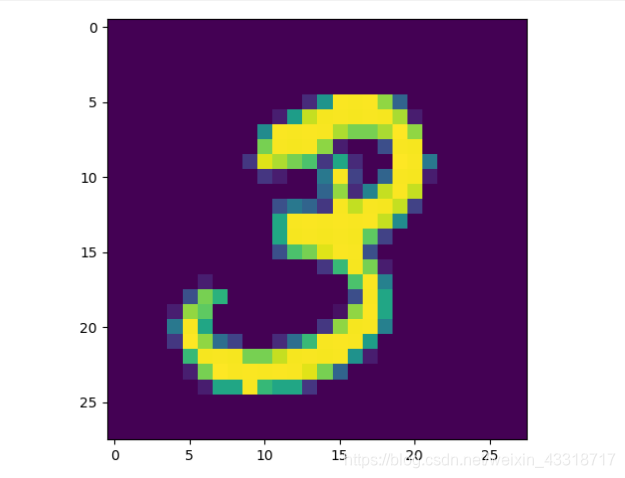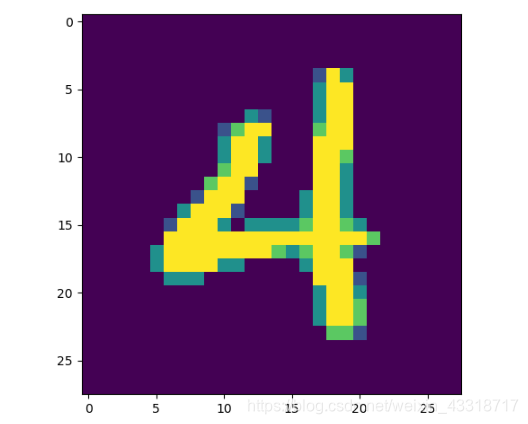从MNIST数据集中选择一幅图,让机器模拟人眼区分手写数字是几
5.1导入图片和数据集
程序:
#1 利用tensorflow代码下载mnist
# http://yann.lecun.com/exdb/mnist/
from tensorflow.examples.tutorials.mnist import input_data
mnist = input_data.read_data_sets("F:/shendu/MNIST_data/", one_hot=True)
#将mnist里面的信息打印出来
print ('输入数据:',mnist.train.images)
print ('输入数据打shape:',mnist.train.images.shape)
import pylab
im = mnist.train.images[1]
im = im.reshape(-1,28)
pylab.imshow(im)
pylab.show()
#查看数据集里面的数据信息
print ('输入数据打shape:',mnist.test.images.shape)
print ('输入数据打shape:',mnist.validation.images.shape)
结果:
Extracting F:/shendu/MNIST_data/train-images-idx3-ubyte.gz
Extracting F:/shendu/MNIST_data/train-labels-idx1-ubyte.gz
Extracting F:/shendu/MNIST_data/t10k-images-idx3-ubyte.gz
Extracting F:/shendu/MNIST_data/t10k-labels-idx1-ubyte.gz
输入数据: [[0. 0. 0. ... 0. 0. 0.]
[0. 0. 0. ... 0. 0. 0.]
[0. 0. 0. ... 0. 0. 0.]
...
[0. 0. 0. ... 0. 0. 0.]
[0. 0. 0. ... 0. 0. 0.]
[0. 0. 0. ... 0. 0. 0.]]
输入数据打shape: (55000, 784)
输入数据打shape: (10000, 784)
输入数据打shape: (5000, 784)

5.2 分析图片的特点,定义变量
5.3 构建模型
5.4 训练模型并输出中间状态参数
程序:
#5.2 分析图片的特点,定义变量
import tensorflow as tf #导入tensorflow库
from tensorflow.examples.tutorials.mnist import input_data
mnist = input_data.read_data_sets("F:/shendu/MNIST_data/", one_hot=True)
import pylab
tf.reset_default_graph()
# tf Graph Input
x = tf.placeholder(tf.float32, [None, 784]) # mnist data维度 28*28=784
y = tf.placeholder(tf.float32, [None, 10]) # 0-9 数字=> 10 classes
#5.3 构建模型
#1 定义学习参数 Set model weights
W = tf.Variable(tf.random_normal([784, 10]))
b = tf.Variable(tf.zeros([10]))
#2 定义输出节点
# 构建模型
pred = tf.nn.softmax(tf.matmul(x, W) + b) # Softmax分类
#3 定义反向传播结构
#损失函数 Minimize error using cross entropy
cost = tf.reduce_mean(-tf.reduce_sum(y*tf.log(pred), reduction_indices=1))
#参数设置
learning_rate = 0.01
# 使用梯度下降优化器
optimizer = tf.train.GradientDescentOptimizer(learning_rate).minimize(cost)
#5.4 训练模型并输出中间状态参数
training_epochs = 25
batch_size = 100
display_step = 1
saver = tf.train.Saver()
model_path = "F:/shendu/521model.ckpt"
# 启动session
with tf.Session() as sess:
sess.run(tf.global_variables_initializer())# Initializing OP
# 启动循环开始训练
for epoch in range(training_epochs):
avg_cost = 0.
total_batch = int(mnist.train.num_examples/batch_size)
# 遍历全部数据集,循环所有数据集
for i in range(total_batch):
batch_xs, batch_ys = mnist.train.next_batch(batch_size)
#运行优化器 Run optimization op (backprop) and cost op (to get loss value)
_, c = sess.run([optimizer, cost], feed_dict={x: batch_xs,
y: batch_ys})
#计算平均loss值 Compute average loss
avg_cost += c / total_batch
# 显示训练中的详细信息
if (epoch+1) % display_step == 0:
print ("Epoch:", '%04d' % (epoch+1), "cost=", "{:.9f}".format(avg_cost))
print( " Finished!")
结果:
Extracting F:/shendu/MNIST_data/train-images-idx3-ubyte.gz
Extracting F:/shendu/MNIST_data/train-labels-idx1-ubyte.gz
Extracting F:/shendu/MNIST_data/t10k-images-idx3-ubyte.gz
Extracting F:/shendu/MNIST_data/t10k-labels-idx1-ubyte.gz
Epoch: 0001 cost= 7.533937749
Epoch: 0002 cost= 4.087300664
Epoch: 0003 cost= 2.859837624
Epoch: 0004 cost= 2.265535372
Epoch: 0005 cost= 1.923775465
Epoch: 0006 cost= 1.702600822
Epoch: 0007 cost= 1.547159600
Epoch: 0008 cost= 1.431017190
Epoch: 0009 cost= 1.340611978
Epoch: 0010 cost= 1.267918987
Epoch: 0011 cost= 1.207861313
Epoch: 0012 cost= 1.157394901
Epoch: 0013 cost= 1.114226475
Epoch: 0014 cost= 1.076534821
Epoch: 0015 cost= 1.043827639
Epoch: 0016 cost= 1.014481443
Epoch: 0017 cost= 0.988165269
Epoch: 0018 cost= 0.964408675
Epoch: 0019 cost= 0.942912809
Epoch: 0020 cost= 0.923217485
Epoch: 0021 cost= 0.904975601
Epoch: 0022 cost= 0.888248457
Epoch: 0023 cost= 0.872694091
Epoch: 0024 cost= 0.858185982
Epoch: 0025 cost= 0.844587765
Finished!
5.5 -5.6 测试模型,保存模型
程序:
#5.2 分析图片的特点,定义变量
import tensorflow as tf #导入tensorflow库
from tensorflow.examples.tutorials.mnist import input_data
mnist = input_data.read_data_sets("F:/shendu/MNIST_data/", one_hot=True)
import pylab
tf.reset_default_graph()
# tf Graph Input
x = tf.placeholder(tf.float32, [None, 784]) # mnist data维度 28*28=784
y = tf.placeholder(tf.float32, [None, 10]) # 0-9 数字=> 10 classes
#5.3 构建模型
#1 定义学习参数 Set model weights
W = tf.Variable(tf.random_normal([784, 10]))
b = tf.Variable(tf.zeros([10]))
#2 定义输出节点
# 构建模型
pred = tf.nn.softmax(tf.matmul(x, W) + b) # Softmax分类
#3 定义反向传播结构
#损失函数 Minimize error using cross entropy
cost = tf.reduce_mean(-tf.reduce_sum(y*tf.log(pred), reduction_indices=1))
#参数设置
learning_rate = 0.01
# 使用梯度下降优化器
optimizer = tf.train.GradientDescentOptimizer(learning_rate).minimize(cost)
#5.4 训练模型并输出中间状态参数
training_epochs = 25
batch_size = 100
display_step = 1
saver = tf.train.Saver()
model_path = "F:/shendu/521model.ckpt"
# 启动session
with tf.Session() as sess:
sess.run(tf.global_variables_initializer())# Initializing OP
# 启动循环开始训练
for epoch in range(training_epochs):
avg_cost = 0.
total_batch = int(mnist.train.num_examples/batch_size)
# 遍历全部数据集,循环所有数据集
for i in range(total_batch):
batch_xs, batch_ys = mnist.train.next_batch(batch_size)
#运行优化器 Run optimization op (backprop) and cost op (to get loss value)
_, c = sess.run([optimizer, cost], feed_dict={x: batch_xs,
y: batch_ys})
#计算平均loss值 Compute average loss
avg_cost += c / total_batch
# 显示训练中的详细信息
if (epoch+1) % display_step == 0:
print ("Epoch:", '%04d' % (epoch+1), "cost=", "{:.9f}".format(avg_cost))
print( " Finished!")
#5.5 测试模型
# 测试 model
correct_prediction = tf.equal(tf.argmax(pred, 1), tf.argmax(y, 1))
# 计算准确率
accuracy = tf.reduce_mean(tf.cast(correct_prediction, tf.float32))
print ("Accuracy:", accuracy.eval({x: mnist.test.images, y: mnist.test.labels}))
#5.6 保存模型
# Save model weights to disk
save_path = saver.save(sess, model_path)
print("Model saved in file: %s" % save_path)
结果:
Extracting F:/shendu/MNIST_data/train-images-idx3-ubyte.gz
Extracting F:/shendu/MNIST_data/train-labels-idx1-ubyte.gz
Extracting F:/shendu/MNIST_data/t10k-images-idx3-ubyte.gz
Extracting F:/shendu/MNIST_data/t10k-labels-idx1-ubyte.gz
Epoch: 0001 cost= 8.105970959
Epoch: 0002 cost= 4.475853801
Epoch: 0003 cost= 3.171927071
Epoch: 0004 cost= 2.533820179
Epoch: 0005 cost= 2.156220097
Epoch: 0006 cost= 1.904493352
Epoch: 0007 cost= 1.724163913
Epoch: 0008 cost= 1.588195300
Epoch: 0009 cost= 1.481576429
Epoch: 0010 cost= 1.395297254
Epoch: 0011 cost= 1.323965988
Epoch: 0012 cost= 1.263911754
Epoch: 0013 cost= 1.212177466
Epoch: 0014 cost= 1.167430636
Epoch: 0015 cost= 1.127955468
Epoch: 0016 cost= 1.093035270
Epoch: 0017 cost= 1.061706158
Epoch: 0018 cost= 1.033252213
Epoch: 0019 cost= 1.007543803
Epoch: 0020 cost= 0.983997456
Epoch: 0021 cost= 0.962346797
Epoch: 0022 cost= 0.942473246
Epoch: 0023 cost= 0.923953633
Epoch: 0024 cost= 0.906754157
Epoch: 0025 cost= 0.890760613
Finished!
Accuracy: 0.8306
Model saved in file: F:/shendu/521model.ckpt
5.7 读取模型
程序:
#5.2 分析图片的特点,定义变量
import tensorflow as tf #导入tensorflow库
from tensorflow.examples.tutorials.mnist import input_data
mnist = input_data.read_data_sets("F:/shendu/MNIST_data/", one_hot=True)
import pylab
tf.reset_default_graph()
# tf Graph Input
x = tf.placeholder(tf.float32, [None, 784]) # mnist data维度 28*28=784
y = tf.placeholder(tf.float32, [None, 10]) # 0-9 数字=> 10 classes
#5.3 构建模型
#1 定义学习参数 Set model weights
W = tf.Variable(tf.random_normal([784, 10]))
b = tf.Variable(tf.zeros([10]))
#2 定义输出节点
# 构建模型
pred = tf.nn.softmax(tf.matmul(x, W) + b) # Softmax分类
#3 定义反向传播结构
#损失函数 Minimize error using cross entropy
cost = tf.reduce_mean(-tf.reduce_sum(y*tf.log(pred), reduction_indices=1))
#参数设置
learning_rate = 0.01
# 使用梯度下降优化器
optimizer = tf.train.GradientDescentOptimizer(learning_rate).minimize(cost)
#5.4 训练模型并输出中间状态参数
training_epochs = 25
batch_size = 100
display_step = 1
saver = tf.train.Saver()
model_path = "F:/shendu/521model.ckpt"
#5.7 读取模型
# 读取模型
print("Starting 2nd session...")
with tf.Session() as sess:
#初始化变量 Initialize variables
sess.run(tf.global_variables_initializer())
#恢复模型变量 Restore model weights from previously saved model
saver.restore(sess, model_path)
# 测试 model
correct_prediction = tf.equal(tf.argmax(pred, 1), tf.argmax(y, 1))
# 计算准确率
accuracy = tf.reduce_mean(tf.cast(correct_prediction, tf.float32))
print("Accuracy:", accuracy.eval({x: mnist.test.images, y: mnist.test.labels}))
output = tf.argmax(pred, 1)
batch_xs, batch_ys = mnist.train.next_batch(2)
outputval, predv = sess.run([output, pred], feed_dict={x: batch_xs})
print(outputval, predv, batch_ys)
im = batch_xs[0]
im = im.reshape(-1, 28)
pylab.imshow(im)
pylab.show()
im = batch_xs[1]
im = im.reshape(-1, 28)
pylab.imshow(im)
pylab.show()
结果:
Extracting F:/shendu/MNIST_data/train-images-idx3-ubyte.gz
Extracting F:/shendu/MNIST_data/train-labels-idx1-ubyte.gz
Extracting F:/shendu/MNIST_data/t10k-images-idx3-ubyte.gz
Extracting F:/shendu/MNIST_data/t10k-labels-idx1-ubyte.gz
Starting 2nd session...
Accuracy: 0.8306
[5 4]
[[1.6561843e-04 5.4651889e-07 2.7361073e-04 3.7989013e-02 1.9851981e-05
5.9364939e-01 6.0037843e-07 9.7130658e-05 3.6701840e-01 7.8581058e-04]
[2.3846442e-07 2.8713408e-16 6.3471548e-06 5.8026183e-07 9.9998915e-01
7.3509878e-09 2.5957190e-06 3.7521692e-09 3.1330194e-07 7.7429326e-07]]
[[0. 0. 0. 0. 0. 1. 0. 0. 0. 0.]
[0. 0. 0. 0. 1. 0. 0. 0. 0. 0.]]


(第一行是模型的准确率,
下边第一个数组是输出的预测结果,
第二个数组是预测出来的真实输出值,
第三个数组是标签值onehot编码表示的5和4)





 博客介绍了利用MNIST数据集进行手写数字识别的过程。包括导入图片和数据集,分析图片特点并定义变量,构建、训练、测试和保存模型,最后读取模型,让机器模拟人眼区分手写数字。
博客介绍了利用MNIST数据集进行手写数字识别的过程。包括导入图片和数据集,分析图片特点并定义变量,构建、训练、测试和保存模型,最后读取模型,让机器模拟人眼区分手写数字。
















 14
14

 被折叠的 条评论
为什么被折叠?
被折叠的 条评论
为什么被折叠?








